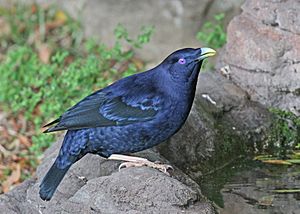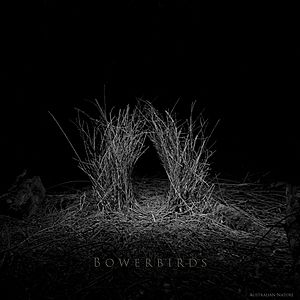Bowerbird facts for kids
Quick facts for kids Bowerbirds |
|
|---|---|
 |
|
| Male satin bowerbird Ptilonorhynchus violaceus |
|
| Scientific classification |
|
| Kingdom: | Animalia |
| Phylum: | Chordata |
| Class: | Aves |
| Order: | Passeriformes |
| Parvorder: | Corvida |
| Superfamily: | Menuroidea |
| Family: | Ptilonorhynchidae G. R. Gray, 1841 |
| Type genus | |
| Ptilonorhynchus Kuhl, 1820
|
|
| Genera | |
|
Ailuroedus |
|
Bowerbirds are a special group of birds known for their amazing way of attracting a mate. The males build and decorate unique structures called "bowers" to impress females. They use sticks and colorful objects to make these artistic displays.
There are 19 different kinds of bowerbirds, found in eight main groups (called genera). These birds are medium to large in size. The smallest, the golden bowerbird, is about 22 cm (8.7 in) long and weighs 70 g (2.5 oz). The largest, the great bowerbird, can be 40 cm (16 in) long and weigh 230 g (8.1 oz).
Bowerbirds mainly eat fruit. But they also enjoy insects, especially when feeding their babies. Some species also eat flowers, nectar, and leaves. Sometimes, bowerbirds like the satin and spotted bowerbirds eat fruits and vegetables from farms.
You can find bowerbirds in New Guinea and Australia. Ten species live only in New Guinea, and eight live only in Australia. Two species live in both places. They live in different areas, like rainforests, eucalyptus and acacia forests, and shrublands.
Contents
Bowerbird Life and Habits
Most bowerbirds have a special way of life. The male bowerbirds build their amazing bowers to attract females. Once a female chooses a male, she builds her own nest and raises the young birds all by herself.
However, there's one group of bowerbirds called Ailuroedus catbirds that are different. The male and female catbirds stay together and raise their chicks as a team.
Nests and Eggs
Female bowerbirds build their nests using soft materials. They often use leaves, ferns, and thin vines. These soft materials are placed on a loose base of sticks.
Bowerbirds in New Guinea usually lay one egg. Australian bowerbirds lay one to three eggs. Their eggs are quite large compared to other birds of similar size. For example, a satin bowerbird's egg weighs about 19 g (0.67 oz).
The eggs hatch after 19 to 24 days. Catbird eggs are plain cream-colored. Other bowerbird eggs often have wavy brownish lines. Even if a bowerbird lays more than one egg, the chicks hatch at different times.
How Long Bowerbirds Live
Bowerbirds are known for living a long time. They have one of the longest lifespans among small to medium-sized birds. The green catbird and satin bowerbird can live for about eight to ten years. One satin bowerbird even lived for 26 years! This is a very long life for a bird of its size.
Courtship and Mating Rituals
The most amazing thing about bowerbirds is how males try to find a mate. They build incredibly complex structures called bowers. These bowers are like special stages for the males to show off.
There are two main types of bowers:
- Maypole bowers: Some bowerbirds build sticks around a small tree. Some even add a roof that looks like a hut.
- Avenue bowers: Other bowerbirds build two walls of sticks standing upright, creating a pathway or "avenue."
The Ailuroedus catbirds are the only bowerbirds that do not build bowers.
Decorating the Bower
Around their bower, male bowerbirds place all sorts of brightly colored objects they have collected. Each species has its favorite items. These can include hundreds of shells, leaves, flowers, feathers, stones, and berries. They might even use human-made items like plastic pieces, coins, nails, or glass.
Males spend many hours arranging these collections perfectly. They sometimes even steal decorations from other males' bowers! Studies show that the colors males use for decorating often match what females prefer.
Male Displays and Optical Illusions
Besides building and decorating, male bowerbirds perform special dances and calls to attract females. They adjust their performance based on how the female reacts.
Bowerbirds are also very good at mimicking sounds. For example, MacGregor's bowerbird can copy the sounds of pigs, waterfalls, and even human voices. Satin bowerbirds often imitate other birds as part of their show.
Some bowerbirds even create amazing optical illusions in their bowers! They arrange objects from smallest to largest. This makes the objects look farther away than they really are, which keeps the female's attention longer. Males who create stronger illusions often have more success finding a mate.
Female Choice
Female bowerbirds visit many different bowers. They watch the males' displays and carefully check the quality of the bower and its decorations. They often return to their favorite bowers several times.
After visiting many bowers, the female chooses her mate. Many females might even choose the same male if his bower and display are the best. Females who mate with a very successful male often return to him the next year.
This complex behavior, with all the special decorations and displays, makes bowerbirds one of the most interesting bird species. Even Charles Darwin, a famous scientist, wrote about bowerbirds because of their amazing courtship rituals.
Bowerbird Family Tree
Scientists used to think bowerbirds were closely related to birds-of-paradise. Both families are from the Australia-New Guinea area. However, newer studies show that bowerbirds are not as closely related to birds-of-paradise as once thought.
The exact family tree of bowerbirds is still being studied. Fossils show that bowerbirds have been around for a very long time, at least 23 to 26 million years!
Here are the main groups (genera) of bowerbirds:
- Genus Ailuroedus (Catbirds)
- Genus Scenopoeetes
- Genus Archboldia
- Genus Amblyornis
- Prionodura
- Genus Sericulus
- Ptilonorhynchus
- Genus Chlamydera
It's important to know that some birds called "catbirds" from other parts of the world, like the Americas or Africa, are not related to these bowerbirds. They just happen to share a similar name.
See also
 In Spanish: Pergoleros para niños
In Spanish: Pergoleros para niños



